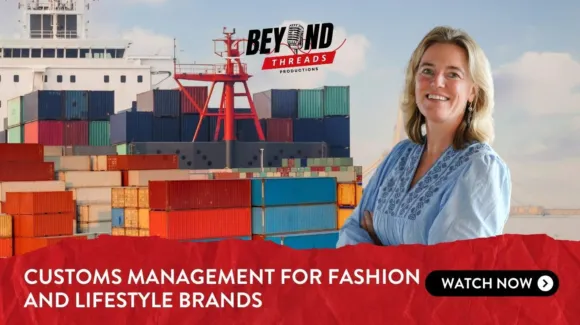At the end of August 2025, the ‘de-minimis’ duty exemption – which allowed small packages valued under $800 to enter the US without being subject to import taxes or tariffs – was suspended by the US government. Before 29 August, the suspension had applied only to packages from China and Hong Kong, but now it applies to all imports regardless of their origin. So, as the dust settles and the effects of this drastic measure become clearer, the question is: how does this rule change affect European fashion brands?
Read on to explore what the latest changes mean for cross-border trade into the United States and how changing legislation is impacting brands of all sizes.
In short. the ‘de minimis’ import duty exemption has been suspended for all packages shipped from Europe and the UK to the US, with potentially severe consequences for brands small and large. However, by adopting a strategic approach to customs management, brands can avoid the worst impacts of the suspension and maintain customer excellence.
Navigating a changing, challenging global trade environment
The decision to pull the plug on the de minimis exemption has significantly disrupted the flow of goods into the United States. Here’s one eye-watering stat that demonstrates the sheer scale of the impact: last year alone, almost 1.4 billion packages – worth a total of more than $64 billion – entered America under the de minimis exemption.
With the rule change applying to both commercial and postal deliveries, European- and UK-based fashion brands now face a wide range of knock-on effects when exporting their goods to the lucrative US market. As tariffs and geopolitical uncertainty impact supply chain operations, we’ll examine the main ways in which the scrapping of de minimis is making brands rethink their operations – and what they need to do about it.
The post-de minimis reality: More red tape, higher costs
The removal of the de minimis exemption means European fashion brands now face significant cost increases on every US-bound shipment of goods. Every parcel – no matter how small – that’s delivered to the US now faces tariffs and requires customs clearance. This disrupts the flow of e-commerce imports into the country that had been enabled by the exemption for lower-value items below the previous $800 limit.
In particular, smaller direct-to-consumer (D2C) brands risk finding themselves the hardest hit because they previously relied heavily on the exemption. The de minimis rule made the US market much more accessible for brands fulfilling orders from around the world. But following the changes, brands are faced with increasing costs when shipping to the US. If they pass these costs onto their US-based customers in the form of higher prices, they risk losing their competitive edge and pricing themselves out of the market.
However, the de minimis impacts aren’t limited to smaller fashion and lifestyle players. Well-established brands like Lululemon are also feeling the squeeze, with the Canada-based activewear producer saying it will pay a $240 million tariff bill this year, which it expects to rise to $320 million in 2026. This is largely because many of the orders that it ships to customers in the US from Canada will now be subject to import taxes. Therefore, strategic customs management is necessary, whatever the size of your company.
Next steps: Overcoming supply chain disruption
As well as rising costs of transporting goods, the end of the de minimis exemption has meant that some postal carriers have stopped or restricted cross-border deliveries to the US. Many delivery providers in Europe and the UK – including national-level services – temporarily paused all shipments to the US. Deliveries have since been resumed, but with an adapted service. For example, Royal Mail now offers a ‘postal delivered duties paid’ service, which includes an additional handling fee to reflect the extra costs incurred. This has made it harder for smaller brands to reliably send goods as before.
The knock-on effect of these carrier decisions has been widespread, particularly for brands that have based a significant part of their business models around D2C fulfilment from Europe to the US. The ongoing disruption means that these apparel and lifestyle brands may be losing sales and should urgently review their shipping strategies or risk losing their hard-won US customer base. For many European fashion brands, this has meant an overhaul of their international distribution model at very short notice.
A strategic approach: Securing customs compliance
With low-value parcels entering the US now requiring full customs clearance, there are new compliance requirements that European fashion exporters must fulfil. For example, any brand that imports items into the US now requires an approved Importer of Record (IOR), an entity that’s legally responsible for compliance with all US customs laws. The IOR must provide detailed commercial invoices, the product’s Harmonised Tariff Schedule (HTS) code and certificates of origin for every single consignment. This is a far more time- and resource-intensive process, particularly for smaller brands without designated customs teams to handle the additional workload and complex obligations.
In addition, the stakes for getting all your paperwork correct are high. Mistakes in documentation can result in shipments being held up at customs, returned to sender or subject to penalties that can erode profit margins. Specifically, an HTS code classification – based on the value and origin of an item – determines the import duty and tariff owed by the IOR, so being accurate is paramount to avoid fines or further disruptions. For brands that previously enjoyed the simplicity of the de minimis exemption, these customs requirements make US fulfilment far more challenging. This highlights the value of an integrated customs management framework that consolidates customs processes, automating tasks and reducing delays, costs and compliance risks.
Looking ahead: What’s next for US fashion imports?
The end of de minimis is forcing international brands that want to continue serving US customers reliably to rethink their fulfilment strategies. And while smaller e-commerce brands will likely be hit hardest, the legislative change will also have a large impact on larger brands. For one major fashion brand, more than 10% of its sales were covered by the de minimis exemption, but now these same orders will be subject to a 30% tariff.
In response, every fashion brand exporting to the US will likely need to adjust or redesign parts of its supply chain in order to protect itself from revenue losses. Some brands are looking at nearshoring their manufacturing to be closer to the US, while others are exploring bonded warehousing solutions and foreign trade zones to keep customs costs under control. The good news? There are ways to adapt and keep serving your US customers effectively. In our upcoming blog posts, we’ll be diving into the practical strategies that smart brands can use to navigate this new reality – so stay tuned for more insights.
Looking for expert customs support or need help adjusting your international supply chain operations in response to the fast-changing global trade landscape? Get in contact with a Bleckmann expert today.
















